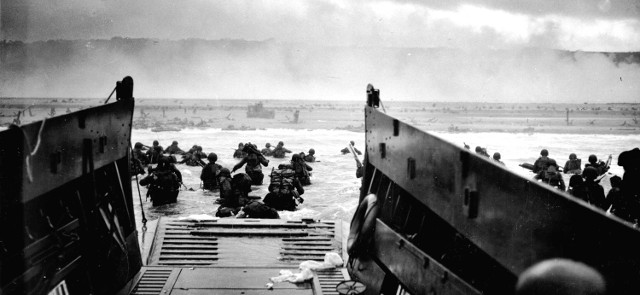
The Normandy Invasion (PDF File) (June 6, 1944) was the supreme joint effort of the Western Allies in Europe in World War II and remains today one of the best known campaigns of the war.
Code named Operation Overlord, it was a battle marked by its courage, meticulous planning and logistics, and audacious amphibious approach. It was also in many ways inevitable. Following Germany’s conquest of France in 1940 and declaration of war on the United States in 1941, a confrontation somewhere on the shores of Northern Europe became a waiting game, with only the date and location left to be answered.
On D-Day, over 125,000 British, American, and Canadian soldiers supported by more than five thousand ships and thirteen thousand aircraft landed in Normandy on five separate beaches in order to carve out a sixty-mile wide bridgehead. This foothold would be the launching point from which the liberation of France and Western Europe would proceed. Opposed by German units in strong defensive positions, the Allies suffered more than twelve thousand casualties on the first day of the invasion.
To commemorate the battle, Origins offers ten of the most important things to know about the invasion.
1. The Stage is Set
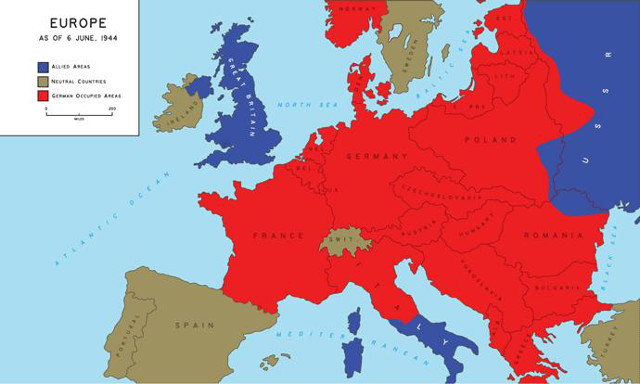
Map of World War II Europe. Axis Powers in red and Allies in blue.
In spring 1944, the Allied war effort had Axis forces retreating on all fronts. On the Eastern Front, Soviet forces had gained an undisputed advantage over the German Army and were advancing into Poland. The Western Allies (mainly Britain and the United States) continued their offensive in Italy, capturing Rome on June 4, while also pummeling Germany with a strategic air bombing campaign. In the Pacific, the British had just defeated a Japanese offensive in India while American forces continued a steady drive towards Japan through a series of island-hopping offensives. The long-awaited offensive to liberate Western Europe seemed imminent.
2. The Invasion was a Compromise
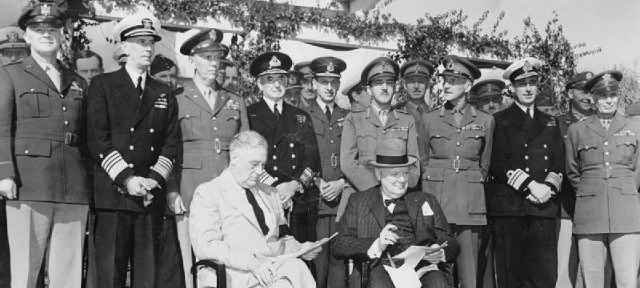
The Allied effort in World War II is generally seen as the finest example of coalition warfare. Yet, the Allies rarely agreed outright, particularly in regards to D-Day. The Americans, despite lacking capability to do so, argued for an invasion in 1943. The British advocated operations in the Mediterranean and the Balkans to erode German military strength. The Soviets simply wanted a sizeable second front against the Nazis to relieve pressure on their forces. The resulting plan was a compromise that left all parties only partly satisfied, but met the strategic needs of every participant.
3. Geography Determined Where the Allies Could Land; Allied Leaders Chose Where They Would
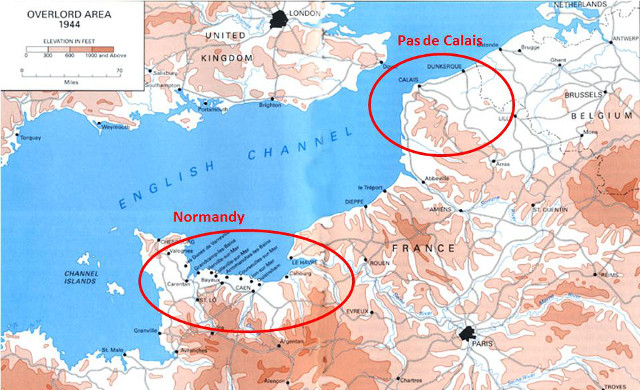
The two possible landing spots for Overlord
An invasion of Europe required specific geographic features to ensure a reasonable expectation of success. The landing spot had to be within range of Allied fighters flying from England, possess large beaches for vehicular traffic, and be close to a port to supply future offensives. Only two possible landing sites fit the bill: the area known as the Pas de Calais region and the Normandy beaches. Serious planning began in 1943 with the appointment of British General Frederick Morgan as the head of a planning staff. General Morgan’s team decided on Normandy because of its lighter defenses and increased distance from German reinforcements. And they opted for one major assault designed to secure a lodgment as opposed to various smaller landings designed to deceive the Germans.
4. Allied Intelligence Successes and Failures
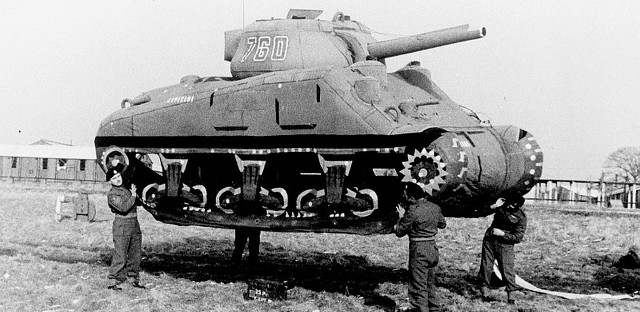
Allied soldiers hold aloft a dummy tank to deceive Germans
The Allies staged a massive deception campaign prior to Overlord called Operation Fortitude. Designed to confuse German intelligence, Fortitude involved the creation of fictitious formations, dummy equipment, phantom radio traffic, falsified press releases, and controlled leaks of information to known German agents. The operation was so successful German units stayed in defensive positions for weeks after D-Day awaiting the “real” invasion. Allied intelligence, however, was not infallible. The inability of intelligence analysts to identify reinforced German formations in Normandy or adequately assess the defensive strength of the hedgerow terrain behind the beaches resulted in a tougher fight for the Allies.
5. Success was Not Assured
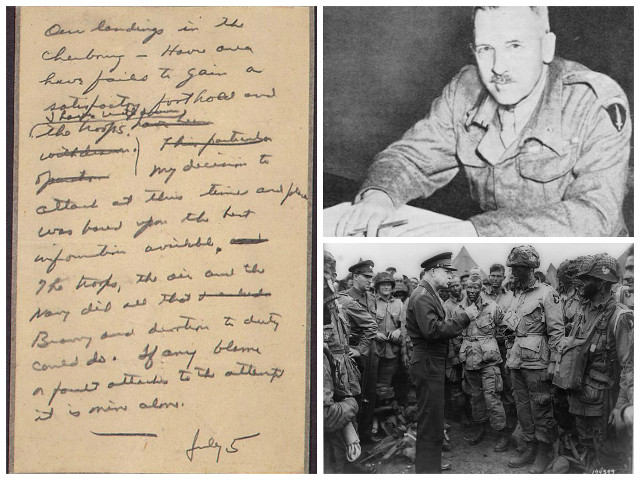
(Top right) Lieutenant-General Frederick Morgan was the head of the planning staff for the invasion. (Bottom right) General Dwight Eisenhower gives his famous “Full victory—nothing else” speech to paratroopers just before the invasion. (Left) Eisenhower was not always so confident as seen in this letter he drafted should the operation fail.
In hindsight, the overwhelming success of the Normandy landings blinds contemporary observers to the very real fear among some Allied leaders that the invasion could fail. General Dwight Eisenhower, the Supreme Allied Commander, went so far as to draft a letter (right) to be read in the event of defeat. In it he accepted full responsibility for the failed attack despite the fact the plan was in its advanced stages when he assumed command. During the invasion, the commander of U.S. forces, General Omar Bradley, considered cancelling further landings on Omaha Beach when the success of operations ashore appeared in doubt.
6. The Pre-invasion Bombardment from Air and Naval Forces was Ineffective
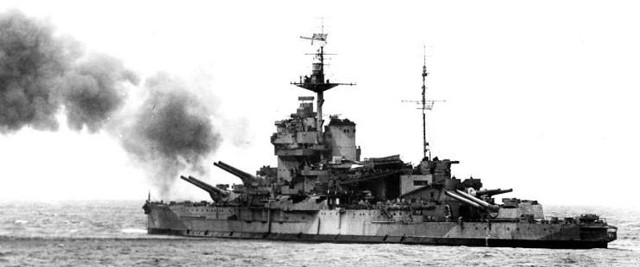
Operation Neptune—the amphibious assault portion of Overlord—called for a brief but intense air and sea bombardment to precede the landings to weaken the beach defenses. Weather caused aircraft to miss targets, but more importantly the brevity of the bombardment determined it would fail. Ignoring advice from amphibious assault experts from the Pacific Theater, Allied planners opted for a short bombardment over an extended one in order to maximize surprise. The attack was far too short to do any real damage, leaving the troops in the initial waves to fight generally unaffected German defenses.
7. But Allied Air Superiority Ultimately Proved a Decisive Element in Victory
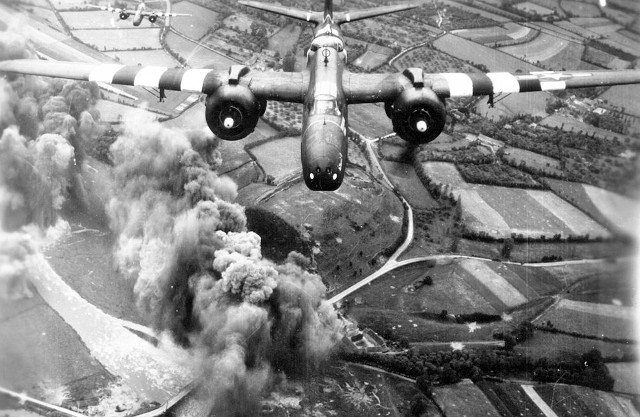
An A-20 bomber from the 416th Bomb Group of the U.S. completing its bombing run, June 1944
Prior to the invasion, Allied bombers isolated Normandy by targeting transportation hubs that could be used to move German reinforcements to the region. During the invasion, air transport units deployed over twenty thousand paratroopers, helping secure the flanks of the beachhead. Allied aircraft cleared the air and ensured the ground and naval forces proceeded unmolested from German air attacks. Following the invasion, Allied air power proved essential in delaying German reinforcements.
8. The Normandy Campaign was a Race to Reinforce the Area
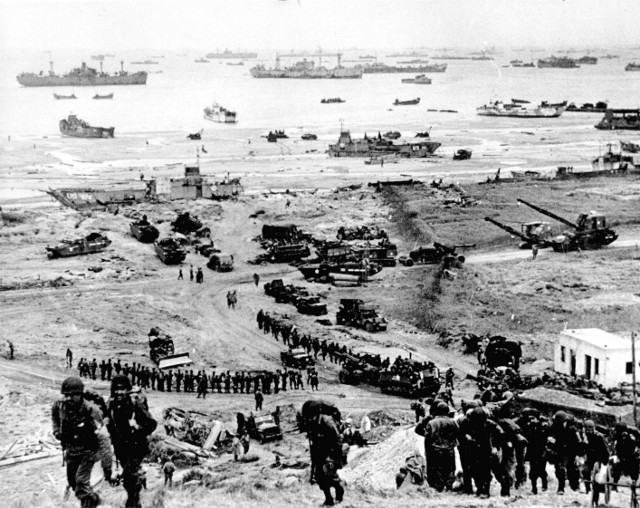
Reinforcing Omaha Beach with men and equipment
The beach landings are what we think of when we imagine Overlord, but it was the question of reinforcements that won the engagement. Whichever side could gain a substantial advantage in force ratios would shift the balance in their favor. Allied efforts were limited by the size of the lodgment, the rate at which troops could be brought across the beaches, and poor weather conditions. German reinforcements, dispersed across France and the Low Countries to counter possible Allied landings, had to combat competing strategic demands and increasingly aggressive attacks from Allied air power. Allied efforts won out, and the bridgehead slowly expanded.
9. The Invasion Did Not Decide the War, But It Did Shape the Post-war World
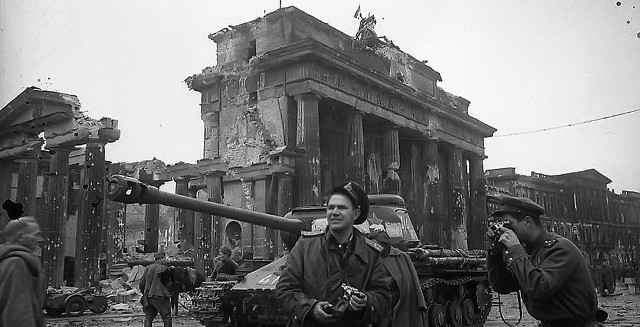
Despite the remarkable achievement that was the D-Day landings, it is important to remember that they did not constitute the decisive blow against Nazi Germany; that success belongs to the Soviet Union. Raging since June 1941, the Eastern Front witnessed the most massive military confrontation in history. At the cost of more than twenty million casualties (military and civilian), the Soviet Union swallowed the Wehrmacht, occupying the majority of its military might, and inflicting almost eighty percent of all combat deaths. However, had the Normandy Invasion failed, the Soviets may have advanced deeper than they did into Germany and central Europe, moving the Iron Curtain farther west and changing the face of the Cold War.
10. D-Day is the Most Heavily Commemorated Battle in the World
In its enduring allure and grandeur, the Normandy invasion enjoys the most prolific commemoration of any battle in the world. In addition to year-round tourist traffic, annual celebrations commemorating the invasions draw thousands of visitors. Heads of state from the United States, the United Kingdom, France, Canada, and Germany have attended in order to reflect on the feat of arms that was D-Day. Various militaries also participate, often staging commemorative parachute jumps. All this is in addition to the cemeteries in Normandy that serve as the final resting spot for thousands of American, British, Canadian, and German soldiers.
